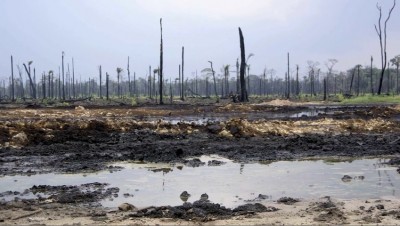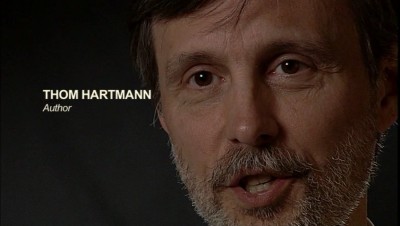| Reviews & Columns |
|
Reviews DVD TV on DVD Blu-ray 4K UHD International DVDs In Theaters Reviews by Studio Video Games Features Collector Series DVDs Easter Egg Database Interviews DVD Talk Radio Feature Articles Columns Anime Talk DVD Savant Horror DVDs The M.O.D. Squad Art House HD Talk Silent DVD
|
DVD Talk Forum |
|
|
| Resources |
|
DVD Price Search Customer Service #'s RCE Info Links |
|
Columns
|
|
|
Crude Impact

The first portion of Crude Impact delves into what oil has provided humanity. By powering mechanized means of food production and distribution and energy-intense fertilizers, fossil fuels (predominately oil but also natural gas and coal) have contributed to the dramatic increase in the global food supply, in turn allowing the world population to swell from about one billion at the turn of the nineteenth century to over six billion at the turn of the millennium. Oil has also fueled the high standard of living achieved in the United States, where four percent of the global population consumes twenty-five percent of the world oil production.
America's disproportionate use of global production is threatened both by natural limits and increased competition. Global oil production has peaked and begun to decline in 15 of the world's 30 largest historic oil-producing counties as existing reserves are consumed and new discoveries prove increasingly rare. Supply cannot keep place with current demand much less the inevitable increase in demand by rapidly industrializing nations such as China and India. In 2005 alone, China's energy demands increased by twenty percent, and the demand for oil is only expected to increase more rapidly as China's population of 1.3 billion continues to transition from a rural agrarian to an urban, industrial society.
 |  |
The documentary further explores the unsavory effects that America's oil dependency has had on foreign policy and corporate practices with consideration of American policy in the Middle East, and corporate environmental and human rights abuses in Latin America and Africa. This is followed by criticism of unchecked consumerism and lax corporate media, and warnings about global warming. Finally, the film wraps up with the obligatory, but in this case half-hearted and inadequate, positive steps that the viewer can take: (1) buy energy efficient appliances and CFC light bulbs; (2) consume local organic food; and (3) participate in the political process. While voting with our dollars and our ballots is an important step, it's not going to be nearly enough. Here Wood fails both to illuminate the scope of the misery the global community is likely to face, and to identify the scope of change that will be need to survive the painful transition to a post-peak oil world.
Wood musters many of the usual suspects for the interviews. These include Richard Heinberg, Michael Klare, and Matthew Simmons, who have each pontificated in at least five documentaries of this kind, and the ubiquitous spokeswoman-of-all-progressive-causes Amy Goodman, but he also taps some fresh sources, most notably the likable talk radio host Thom Hartmann in what I believe is his freshman documentary appearance (Hartmann subsequently appeared in The 11th Hour).
 |  |
Though the makers of Crude Impact collectively had very little prior filmmaking experience, you wouldn't know it from the film's production values. The mix of talking heads interviews, archival and new footage, and graphics looks polished.
Presentation
Video:
Crude Impact, presented in an anamorphic 16x9 aspect ratio, blends archival and new footage. While the archival footage is of varying quality, the new material looks about as good as its digital video source will allow.
Audio:
The 2.0 stereo audio sounds mostly fine with some separation between channels on the score, though audio quality diminishes on a couple of the archival pieces. Optional subtitles are provided in French and Spanish.
Extras:
Over an hour of additional interviews are provided arranged by topic. Experts interviewed but not included in the main feature are relegated to here, but unfortunately they interviewees are not identified.
Final Thoughts:
As a broad overview of the impact of oil on American society, and the adverse future consequences American oil dependence is likely to have as global supply contracts while demand increases, Crude Impact works, but viewers looking for persuasive advocacy for alternatives to this status quo will have to look elsewhere. While the overview of the problem is adequate, Wood's solutions of buying local organic food and changing light bulbs is far too little, and while being politically active is a good suggestion, it's far too nebulous. If you're new to the issue of American oil dependence check out Crude Impact, but then see The Power of Community: How Cuba Survived Peak Oil (2006) for some ideas (albeit still limited) on preparing for life after peak oil.
|
| Popular Reviews |
| Sponsored Links |
|
|
| Sponsored Links |
|
|
| Release List | Reviews | Shop | Newsletter | Forum | DVD Giveaways | Blu-Ray | Advertise |
|
Copyright 2024 DVDTalk.com All Rights Reserved. Legal Info, Privacy Policy, Terms of Use,
Manage Preferences,
Your Privacy Choices | |||||||














